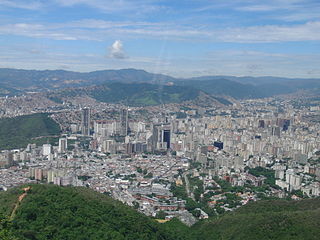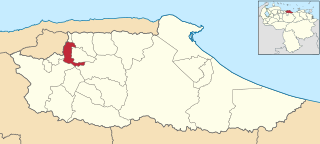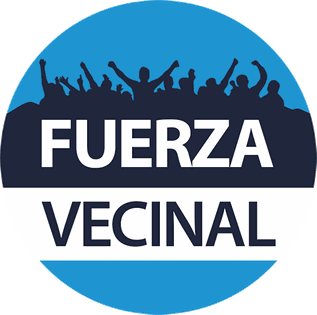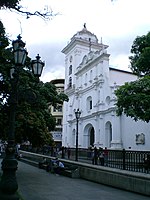
Caracas, officially Santiago de León de Caracas (CCS), is the capital and largest city of Venezuela, and the center of the Metropolitan Region of Caracas. Caracas is located along the Guaire River in the northern part of the country, within the Caracas Valley of the Venezuelan coastal mountain range. The valley is close to the Caribbean Sea, separated from the coast by a steep 2,200-meter-high (7,200 ft) mountain range, Cerro El Ávila; to the south there are more hills and mountains. The Metropolitan Region of Caracas has an estimated population of almost 5 million inhabitants.

Miranda State is one of the 23 states of Venezuela and the second most populous after Zulia State. As of the 2011 census, it had a population of 2,675,165 residents. It also has the greatest Human Development Index in Venezuela, according to the Venezuelan National Institute of Statistics. The most recent population estimate was 3,194,390 in mid-2016.

La Guaira State, known until 2019 as Vargas State, is one of the 23 states of Venezuela.

The Capital District is a federal district of Venezuela. It has an area of 433 km2 (167 sq mi) and there is only one administrative division (municipio), Libertador, which contains about half of Caracas, the Venezuelan capital city, which is also the seat of the three branches of the federal government of Venezuela. The population in 2004 was 2,073,768. The District borders on the states of Vargas and Miranda.

Chacao is one of the five political and administrative subdivisions of the city of Caracas, Venezuela. The other four are Baruta, El Hatillo, Libertador and Sucre. This legal entity is known as the Caracas Metropolitan District. Chacao is also one of the 21 municipalities that make up the State of Miranda, Venezuela.

Municipalities of Venezuela are subdivisions of the States of Venezuela. There are 335 municipalities dividing the 23 states and the Capital District.

Baruta is a municipality within the Metropolitan District of Caracas in Venezuela.

El Hatillo Municipality is an administrative division of the State of Miranda, Venezuela; along with Baruta, Chacao, Libertador and Sucre, it is one of the five municipalities of Caracas, the capital of Venezuela. It is located in the southeastern area of Caracas, and in the northwestern part of the State of Miranda.

Dulce Nombre de Jesús de Petare is a neighborhood in Miranda, Venezuela, and is part of the Metropolitan District of Caracas. It is located in the Sucre Municipality, one of the five divisions of Caracas. The city was founded in 1621 under the name of San Jose de Guanarito. It grew to become a part of the Greater Caracas area as the latter expanded in area and population. Petare had a population of 372,106 inhabitants and about 448,861 according to 2020 estimates. Petare is the biggest slum in Venezuela, and in South America.

The Francisco Fajardo Highway is the most important freeway of Caracas, connecting the west and east sides of the city. The national freeways and many of the avenues of Caracas are not designated with a system of codification or numbering; instead they are designated with the names of historical personages. This highway is named for the conquistador Francisco Fajardo. Also in Caracas, the connections between freeways are also given peculiar names - the octopus, the spider and the centipede are examples.

European Venezuelans, also known as White Venezuelans are Venezuelans who self-identify in the national census as white, tracing their heritage to European ethnic groups. According to the official census report, although "white" literally involves external caucasoid features such as fair skin, hair, and eyes, among others, the term "white" has been used in different ways in different historical periods and places, and so its precise definition is somewhat confusing.
The following is a timeline of the history of the city of Caracas, Venezuela.

Tourism in Venezuela has been developed considerably for decades, particularly because of its geographical position, the variety of landscapes, the richness of plants and wildlife, the artistic expressions and the privileged tropical climate of the country, which affords each region throughout the year. Since 2013, the country is having a very severe economic and political crisis affecting tourism all over the country.

East Caracas generally refers to the eastern portions of Caracas, and may refer specifically to the municipalities from the Metropolitan District of Caracas located in Miranda State: Chacao, Baruta, Sucre, and El Hatillo. It concentrates the 34.8% population of the Metropolitan District of Caracas, and the 21.7% population of the Greater Caracas Area. Caracas Country Club, the richest neighborhood of the city, is located between El Recreo and Chacao districts.

Caterina Valentino Paladino is a Venezuelan-Italian journalist, television presenter, announcer, writer, actress, model and businesswoman. She is one of the most recognized and important figures in Venezuela and has won many awards for her professional work.

The Neighborhood Force is a centrist and localist Venezuelan political party, founded by a group of mayors and political leaders of the country on June 26, 2021. The party governs throughout eastern Caracas — in the municipalities Baruta, El Hatillo, Los Salias and Chacao— less in the Sucre Municipality. The party also governs the municipalities Diego Bautista Urbaneja and Maneiro, in eastern Venezuela.

Gloria Lizárraga de Capriles was a Venezuelan politician who was the first mayor of the Baruta municipality elected by direct vote, as well as the first woman elected to the position. She has been described as one of the pioneering women in Venezuelan politics.
























